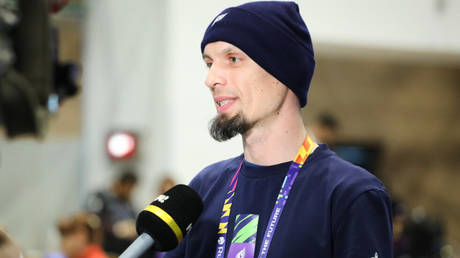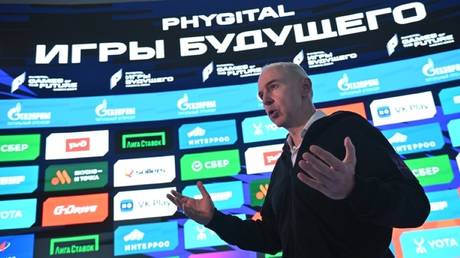
Robot shows, dancing for everyone, and cyber prostheses trials: Why Games of the Future have become an important social project


The Games of the Future in Kazan have become an important phenomenon in sports and a significant social project. The competition program included cybathletics, a unique discipline for people with disabilities, who vied to be the best at using cyber prostheses, electric wheelchairs, and neural interfaces. In turn, robot battles and dance simulator competitions were a hit with families, as the tournament turned out to be interesting even for the youngest viewers.
The Games of the Future in Kazan have become not only a major event in the world of sports and information technology, but also something that can change the lives of many people for the better.
For example, cybathletics competitions for people with disabilities were held in the science city of Innopolis. The participants navigated an obstacle course, completing tasks with the help of modern rehabilitation tools, including electric bicycles, bionic prostheses, and neuro-interfaces.
Most of the tasks were based on everyday activities: climbing stairs, driving across a narrow bridge, opening a door, moving small objects, etc. But for people using prosthetics and electric wheelchairs, these are real challenges. However, it’s difficult for any athlete to cope with some hurdles without preparation.
“The last time, I had to shoot an arrow. I really doubted I could do it with two prosthetic arms, but I could,” Sergey Bachu, a sports delegate of the discipline and an experienced cybathlete, told RT.
 ‘The most important thing is to accept yourself’ – cybathlete Bachu on prosthetic hands and the Games of the Future in Kazan
‘The most important thing is to accept yourself’ – cybathlete Bachu on prosthetic hands and the Games of the Future in Kazan
Such events are very important for people with disabilities, primarily in terms of motivation. They help them find purpose, learn new skills, and believe in themselves. They prove that the absence of an arm or leg is no barrier to having a lively, active lifestyle, especially today, in the era of innovative technologies. Participants communicate a lot at tournaments, sharing their life experiences and telling each other how they can best use technical means of rehabilitation to improve everyday life.
On the other hand, cybathletics is also important for the manufacturers of assistive technologies. At competitions, developers receive feedback from athletes about the functional features of their products. They can see what works well and what needs to be improved, and also check out their competitors’ new products.
“Our desire is to see cybathletics become similar to Formula 1. We want to turn it into an engineering competition. First of all, this is vital for improving the quality and convenience of the developers’ products. Our big goal is to make this sport a growth driver for the entire industry,” Kirill Korotkov, coordinator of international cybathletics teams at the Games of the Future, told Tatarstan 24.
Innopolis was chosen as the venue for these unique competitions for a reason. As Tatarstan’s deputy prime minister, Roman Shaykhutdinov, noted, one of the leading rehabilitation centers for people with disabilities is located in Naukograd (science town), so their needs are well understood here.
“The whole city was originally designed so that it would be convenient for everyone. I have visited almost all of the Games of the Future venues, but it seems to me that cybathletics has the coolest spirit and great energy! These competitions are important. Here, people demonstrate willpower and what opportunities technical means of rehabilitation can provide,” the official said.
Of particular interest is the fact that this Games of the Future discipline will soon become even more digitized. According to Cybathletics Union General Director Alexander Lyubinsky, development of a computer version of the competition is currently underway.
 ‘It’s like Wimbledon’: Games of the Future boss shares numbers and plans for next tournaments
‘It’s like Wimbledon’: Games of the Future boss shares numbers and plans for next tournaments
The mix of cybersports and traditional sports is also important in terms of bridging the gap between generations, helping them find a common language. While BMX bikes, freestyle riding and snowboarding were all the rave for the generation of the early 2000s, today’s young people are all about computer games and social networks. Bringing all these things together on one platform gives people of all ages an opportunity to find something of interest.
Given that, it’s no surprise that the tournament in Kazan has proven to be attractive for large families. For example, Joseph Schutzman, an American IT specialist who now lives outside of Moscow, took his four children to the capital of Tatarstan to see the games.
“Russia is a country of opportunities. And Kazan is Russia’s IT capital. We are very happy to be here. When we heard about the Games of the Future, we immediately knew that we had to see them. I have never heard of such events before. It is very exciting,” Joseph told RT.
The Dance Simulator and VR Rhythm Simulator competitions also had a great family turnout. For three days, all visitors to Kazan Expo Center and Mega Kazan mall were invited to take part in the qualification tournaments in these two disciplines. Naturally, only real pros got into the finals. However, everyone enjoyed the chance to dance a little to great music. It was definitely a favorite with all the children.
Robot battles were yet another favorite with families with kids on the Games of the Future roster. The teams that competed in the ring at the Kazan Circus put on a real show for the audience. There was even some real fire. In the final game of the tournament, the robotic car operated by the Daddy Bots team burst into flames.
“It wasn’t the first time. It really has become a sort of tradition for us. During our training sessions prior to big tournaments, our robots would burn pretty often because we operate very close to their maximum power limits. This time, the auger rotors punctured the battery, which caused the fire. It was a fiery finale. We are fans of spectacular battles and we are really thrilled with how it all worked out. The battle of robots is a show. If our robot simply got flipped over, it wouldn’t have been nearly as much fun,” said Artyom Yumashev, captain of Daddy Bots.
